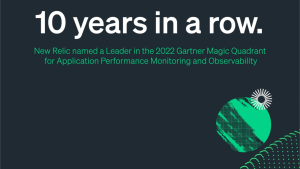I’ve been in the software business for more than two decades, and I believe we’re in a golden age for the industry. The rise of the SaaS business model means customers can insist on getting services that meet their needs, rather than buy licensed software that may not. Game-changing technological advances such as the public cloud, open source, and artificial intelligence are providing developers with incredible tools to build truly amazing things, now and for many years to come.
But it’s also a golden age for IT leadership. It’s no easy thing to figure out how to take advantage of these historic trends—and all too easy to be overwhelmed by the sheer pace of change. Leaders that can marshal these forces, however, can deliver game-changing customer experiences and create new business opportunities that can transform their companies. In other words, they play offense with software.
I’ve had the privilege of getting to know many remarkable IT leaders, especially as we’ve built on New Relic’s strong position with individual and small teams of developers to partner with larger departmental or enterprise-wide initiatives. These leaders come in many forms, from t-shirt-wearing, silo-busting young technologists to savvy corporate officers who know how to pull the right organizational strings to ease huge operations into disruptive change. While there’s no simple recipe, I have noticed some common ingredients in most of these success stories.
Set a high bar
Back when IT was about keeping the website up and the email moving fast, IT leaders were a fairly risk-averse bunch. It made little sense to take big risks, and plenty of sense to focus on maintaining stability and lowering costs. That’s changed. Whatever you think about the over-used phrase “digital transformation,” you can bet on this: the IT leaders of your competitors are under intense pressure to use technology as a strategic weapon to improve business results. In this environment, setting safe, easily attainable goals isn’t really safe at all.
 There’s an art to setting aggressive goals that your team can get behind. Take the CTO of one of our major retail customers. A few years into a big e-commerce push, the company suffered a high-profile peak-season outage. For the following year, she raised the target for uptime for the Black Friday weekend to near perfection.
There’s an art to setting aggressive goals that your team can get behind. Take the CTO of one of our major retail customers. A few years into a big e-commerce push, the company suffered a high-profile peak-season outage. For the following year, she raised the target for uptime for the Black Friday weekend to near perfection.
Her team was initially dubious, but she carefully explained the real cost of the outage and the dollar-and-cents business value of hitting the higher mark. It sent a clear signal to the IT team that what they do matters for the entire company, that they weren’t just working to hit an arbitrary, abstract performance target. The team set about rearchitecting everything that had contributed to the outage. For the last two years, they’ve had 100% uptime during their critical peak shopping season. Her advice coming out of this experience, which she shared with me, was “Don’t fear failure, and focus on doing everything possible to win as a team.”
Start smart
A few years ago, a leader at one of our largest media customers had a very full plate. He was in the middle of integrating the IT platforms across 20-plus business units, and building a streaming platform that could help defend against Netflix and other new competitors. It was obvious they needed to move to the cloud for agility, and the team decided to move quickly to AWS. But while they were under pressure to move fast, this leader insisted on taking the time to prepare a smooth, controlled transition. As we always advise customers: “go slow to move fast.”
“Before we can even talk about cloud migration, we had to know how many servers we have across all these business units,” he told me. We were hired to help instrument their infrastructure to get this information, and to create dashboards so the team could easily visualize and manage how traffic was shifting from on-prem servers to AWS on a monthly basis. The patience paid off: Among its accomplishments, one of the company’s properties recently set a record for simultaneous streaming of a live sporting event to millions of viewers.
Not every project needs to be a headline grabber. For companies that aren’t as far on their journey to modernize their IT operation, the goal can simply be to lay a strong foundation. A few years ago, the CTO of a large insurance company came to us for help with the three basic components of most digital transformations: moving to the cloud, moving to DevOps, and optimizing for customer experience. Now, the company has 200 separate DevOps teams that are busily cranking out mobile apps for consumers, easier-to-use applications for agents, and more. The company’s technology practices may not be bleeding edge, but they have enabled a major transformation that is helping the company compete in this modern age.
Partnership is critical
In a SaaS world, your vendors have every incentive to help you be successful. Take advantage. For example, many of our thousands of customers are working on digital transformations, giving us a good sense of best practices across many industries. That makes New Relic a valuable neutral advisor for a CTO trying to decide which people and processes to retain from across this sprawling empire. As another CTO recently told me, “We need our good partners to step up and show us what great looks like, because we don’t have the time.”
Many of our most accomplished customers use this information in concrete ways. For example, the aforementioned media company executive leveraged the fact that we were working with each of the 20-plus IT operations as he looked to create that single, integrated platform. He asked for our informed opinion to identify the best people, processes, and technologies from across these 20-plus organizations. When we reported at one point that we were having difficulty getting the necessary access to all of these IT groups, he took the feedback to heart. He later told me our advice factored into a decision to reorganize his department into a flatter, more responsive structure.
Don’t wait for marching orders
The savviest companies out there are thinking about how technology can drive their growth, not how it can be used to support someone else’s good idea. Amazon’s decision to start AWS wasn’t the result of a “eureka” moment by Jeff Bezos. It was his just-as-inspired realization that the infrastructure driving Amazon’s e-commerce success could be sold to others.
At most companies, it will fall on the CTO to listen carefully for good ideas from her technical people, and then forcefully champion them to the C-suite. The more that IT leaders step up to this challenge, the more company strategy will align with reasonable technology roadmaps. Essentially, these leaders must be effective translators between their technology teams and C-suite executives. When these groups are in alignment, companies quickly learn what it means to “play offense with software.”
We’re seeing this happen at a broad range of customers, from digital upstarts to decades-old airlines. For example, London-based Ocado began delivering groceries directly to consumers’ homes way back in 2002. While home delivery has only recently begun to increase in the United States, Ocado has built a $1 billion-plus business by figuring out how to deliver produce from traditional grocers via hyper-efficient distribution and delivery vehicle networks. Now, it is using technology to expand the business by providing its service as a platform that the grocery chains can use themselves. At the same time, we have helped some of the world’s leading airlines move rapidly to modernize sprawling legacy systems, improving everything from the quality of their in-airport kiosks to their mobile apps.
Keep a broad field of view
CTOs have their hands full just keeping up with megatrends like DevOps, migration to the cloud, open source, and security. But the best ones keep an eye on another unique challenge in this Golden Age: the potential for an Amazon, Apple, or Google to decide it wants to be in your business.
A CTO of a leading entertainment business once put it to me very simply: the race was on to see if old-guard content owners could develop technology chops faster than technology companies could develop their content brands.
Even companies in industries that Big Tech has left alone need to be vigilant. Who would have predicted that Google would try to disrupt cargo delivery or that Amazon would get into healthcare? Smart CTOs are careful not to measure their progress against only their traditional rivals. Says the former CTO of a fast-growing retailer, “You don’t know what they’re going to do, but you do know that whatever they put out there isn’t going to crap out. When was the last time Apple did a truly lousy product?”
It’s a safe bet that someone out there is leveraging software to compete with you more effectively. The technologies are powerful, broadly accessible, and available in a wide range of packages and price points. In such a world, playing offense as an IT leader may be the safest thing you can do.
The views expressed on this blog are those of the author and do not necessarily reflect the views of New Relic. Any solutions offered by the author are environment-specific and not part of the commercial solutions or support offered by New Relic. Please join us exclusively at the Explorers Hub (discuss.newrelic.com) for questions and support related to this blog post. This blog may contain links to content on third-party sites. By providing such links, New Relic does not adopt, guarantee, approve or endorse the information, views or products available on such sites.


